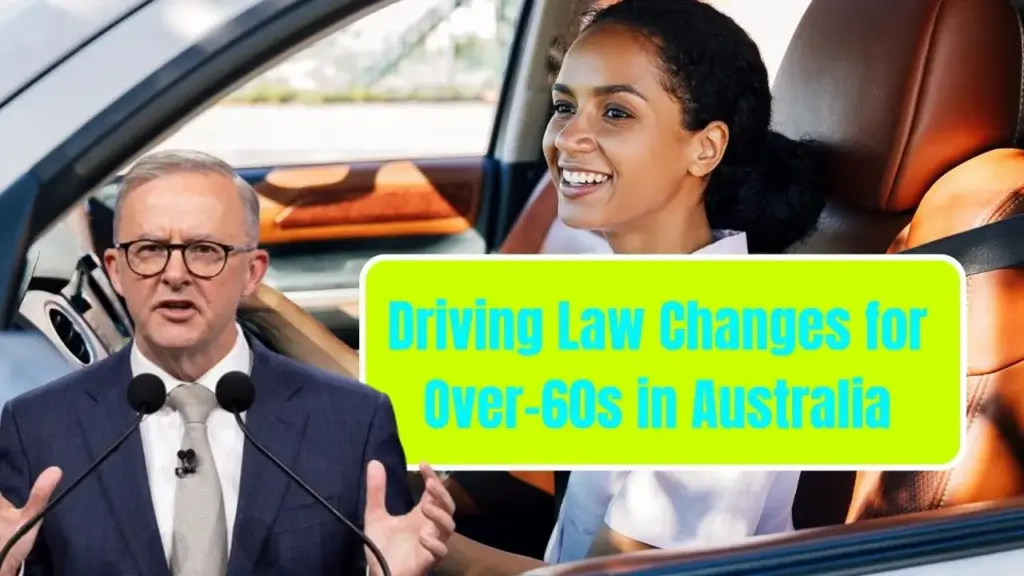From August 2025, new driving law changes for over-60s in Australia will take effect, introducing stricter medical assessments, altered licence renewal conditions, and in some cases, on-road testing. The reforms, announced in response to growing safety concerns, aim to strike a delicate balance between ensuring public safety and preserving independence for older Australians.

With the country’s ageing population and a steady increase in licence holders over the age of 75, state and federal governments are facing mounting pressure to introduce clear, uniform standards. These new measures are intended to prevent avoidable accidents while recognising the crucial role that driving plays in maintaining mobility, social inclusion, and quality of life for older citizens.
Driving Law Changes for Over-60s in Australia
| Key Fact | Detail / Who It Affects |
|---|---|
| Medical assessment threshold | Age requirements lowered in some states; from 75 in most jurisdictions, earlier in others |
| Licence renewal changes | Shorter validity periods; more frequent renewals and conditional licences |
| Practical assessments | Required from age 85 in some states; discretionary in others |
| National variation | Rules differ by state and territory; no single uniform law |
Why the Shift?
Australia’s population is ageing rapidly, with people aged over 65 now making up nearly one-fifth of the national population. Over the past decade, the number of drivers aged 85 and older has risen by more than 70 per cent, reflecting both demographic change and a cultural preference for mobility independence.
This demographic shift coincides with a series of high-profile road accidents involving elderly drivers. In several instances, drivers in their 80s or 90s lost control of their vehicles, causing fatal crashes in residential areas. Each tragedy has prompted renewed debate over whether current licensing rules adequately address the risks posed by age-related decline in vision, cognition, and reflexes.
Critics argue that without regular, mandatory medical checks, some drivers remain on the roads despite suffering from conditions such as dementia, advanced cardiovascular disease, or significant mobility impairment. Supporters of reform emphasise that updated rules could help identify at-risk drivers before accidents occur. At the same time, opponents warn against overgeneralisation, stressing that many older drivers remain safe and responsible behind the wheel.
Medical and Health Assessments
The centrepiece of the reforms is a system of more frequent medical evaluations for drivers in older age brackets. In most states, drivers aged 75 or older will now be required to provide an annual medical certificate confirming fitness to drive.
Doctors are asked to consider a wide range of conditions, including:
- Vision impairment: Regular sight testing ensures drivers meet minimum requirements for distance vision, depth perception, and peripheral awareness.
- Cognitive health: Dementia, Alzheimer’s disease, and other neurological disorders can impair judgement, reaction times, and spatial awareness.
- Cardiovascular disease: Heart conditions that cause dizziness, fainting, or fatigue must be assessed to prevent dangerous incidents behind the wheel.
- Mobility limitations: Arthritis, musculoskeletal disorders, or conditions affecting hand-eye coordination can compromise the ability to steer or brake.
Medical practitioners now hold a central role in determining whether a patient remains fit to drive. In many jurisdictions, doctors must file reports directly to licensing authorities if they believe a patient poses a risk to themselves or others.
Licence Renewal and Conditional Licences
Alongside medical checks, older drivers will encounter shorter licence validity periods. While younger drivers may hold licences valid for up to ten years, drivers past 75 in some states will only be able to renew annually or biennially.
Authorities have also expanded the use of conditional licences. These licences restrict the circumstances under which older drivers may operate their vehicles. Examples include:
- Driving only during daylight hours
- Limiting travel to within a defined radius from home
- Restricting access to freeways or high-speed roads
Conditional licences are issued when medical checks reveal impairments that may not prevent all driving but create unacceptable risks in certain conditions. Supporters argue that this approach provides a middle ground between unrestricted driving and total licence revocation, preserving autonomy while protecting the public.
On-Road Assessments
Practical driving assessments remain one of the most contentious aspects of the reforms. In several states, drivers over the age of 85 are now required to undergo biennial on-road tests to prove their competence.
These tests typically cover:
- Vehicle control, including braking and acceleration
- Observation, lane discipline, and adherence to road signs
- Reaction to unexpected hazards
- Ability to navigate both urban and suburban environments
The measure has sparked debate. Advocates insist that a short practical test provides an objective measure of capability, supplementing medical checks that cannot always predict on-road behaviour. Critics argue the tests place unnecessary stress on older drivers, risk unfairly penalising nervousness rather than unsafe driving, and duplicate assessments already conducted by general practitioners.
State-by-State Rules
Driving law changes for older Australians remain inconsistent across states and territories. While the new framework introduces broad expectations, local implementation varies:
- New South Wales: Annual medical assessments from age 75; mandatory on-road tests every two years from 85.
- Queensland: Drivers 75+ must carry a valid medical certificate whenever driving; renewal depends on certification.
- Victoria: No mandatory medical or driving assessments at a fixed age, but self-reporting of medical conditions is required. Authorities can demand checks after incidents.
- Western Australia: Annual medical checks from age 80; on-road tests only if recommended by a doctor.
- South Australia: Self-assessment medical form issued annually from 75; follow-up medical or practical tests if concerns arise.
- Tasmania: From late 2025, drivers over 85 will no longer face mandatory driving assessments, though medical checks remain.
- Australian Capital Territory and Northern Territory: Annual medical checks begin at age 75, with discretionary follow-up testing.
This patchwork of rules continues to cause confusion for drivers who move between jurisdictions or hold multiple residences. Several transport bodies have called for harmonisation, but state governments remain cautious about relinquishing control.
Expert Views and Public Debate
The reforms have divided opinion among experts, policymakers, and the public.
- Safety advocates argue that mandatory checks are necessary to ensure road safety, citing evidence that age-related decline inevitably affects driving ability.
- Medical professionals highlight the strain on general practitioners, who are increasingly tasked with evaluating driving competence alongside regular patient care. Many call for clearer national guidelines to standardise assessments.
- Senior advocacy groups warn of age discrimination, arguing that many older drivers are unfairly penalised despite strong records of safe driving. They call for a system that evaluates individuals based on ability, not arbitrary age thresholds.
- Transport economists point out the potential social consequences of restricting licences, noting that many older Australians, particularly in rural areas, rely heavily on private vehicles for healthcare, shopping, and social connections.
The Human Dimension
For many Australians, driving represents far more than transport. It symbolises independence, dignity, and participation in community life.
The loss or restriction of a licence can lead to social isolation, increased reliance on family members, and reduced access to healthcare. Advocacy organisations emphasise the need to expand alternative transport services, such as community buses, subsidised ride-sharing, or improved regional public transport.
At the same time, families often struggle with the emotional burden of persuading elderly relatives to give up their keys. While the new rules shift some of this responsibility onto medical professionals and licensing authorities, the decision remains deeply personal and often fraught with tension.
International Comparisons
Australia is not alone in confronting the question of older drivers.
- United Kingdom: Drivers over 70 must renew their licences every three years but are not subject to mandatory medical checks unless they self-report conditions.
- United States: Rules vary widely by state, with some requiring vision tests or shortened renewal periods for older drivers.
- Japan: Drivers over 75 must pass cognitive function tests and, in some cases, practical driving exams.
Australia’s approach falls somewhere between the leniency of the UK and the strict testing regimes of Japan, reflecting an attempt to balance safety with social inclusion.
What Older Drivers Should Do Now
For those approaching or surpassing 60, preparation is essential. Experts advise:
- Check your state’s rules to understand age thresholds for medical certificates, renewals, or driving assessments.
- Schedule regular medical reviews to address vision, hearing, and cognitive changes before they affect your driving.
- Consider conditional licences as a constructive alternative to losing your licence entirely.
- Plan for alternatives in case restrictions are imposed, exploring public transport, ride-sharing, or community services.
- Stay proactive by updating family members about your health and capacity to drive safely.
New $1000 Driving Fine in Australia Starts October 1 – Don’t Get Caught Out
Australia Updates Driving Laws for Seniors: What Drivers Over 70 Must Do from October 2025
Looking Ahead
The reforms signal a new era in Australia’s approach to driving law changes for over-60s. While implementation will differ across states, the underlying trend is clear: greater scrutiny, more frequent medical involvement, and expanded use of conditional licences.
Whether the measures succeed in reducing accidents without unfairly restricting older drivers will be closely watched in the coming years. Policymakers face the challenge of refining the system while balancing fairness, safety, and independence.
For now, one reality is unavoidable: as Australia’s population ages, the conversation around driving, health, and autonomy will remain at the forefront of public debate.
















